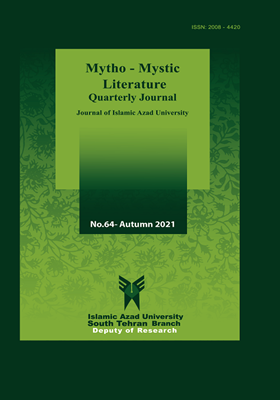Schemas in Kashf-ul-Mahjoob and Tazkirat al-Awliyā (A Case Study: Hallāj)
Subject Areas : Mytho
1 - The Assistant Professor of Persian Language and Literature, Farhangian University of Kerman
Keywords: semantic, Hallaj, Attār Neishapouri, Hujwīrī, Motion Scheme,
Abstract :
The depth of Hallaj's words and their being mysterious have caused the Muslim mystics to resort to a special language to reflect his states. Metaphor, in terms of the capabilities of illustration and transmission of concepts, is the most important lingual tool for explaining the inexpressible experiences of the mystics. When words fail in expressing the ideas, pictorial metaphors help the mystic to better express his/her mystical experiences and inner concepts. Using descriptive-analytical method and based on library resources, the present article attempts to show how mystics, especially Attār Neishapouri and Hujwīrī, conceptualize Hallaj's spiritual experiences and analyze his complex personality. The study shows that Attār has used metaphorical concepts more than Hujwīrī to show the mystical world of Hallaj.The results show that the motion scheme is used more than other schemas and with its help the abstract concepts of enthusiasm, vesāl (joining), knowledge, satisfaction, etc. are represented. Thus, the motion scheme is the dominant one; it shows that the mystics consider the universe to be in constant flux and evolutionary process. At the same time, it shows that Attar's style is more artistic and mystical than Hujwīrī 's style.
بقلی شیرازی، روزبهان .1373 . شرح شطحیات. بهکوشش هنری کربن و محمد معین. تهران: انجمن ایرانشناسی.
باقری خلیلی، علیاکبر و دیگران. 1392. «طرحواره چرخشی در غزلیات سعدی وحافظ». فصلنامة نقد ادبی. ش23.
حسنپور آلاشتی، حسین و دیگران. 1395. «تحلیل شناختی فنای نفس در غزلیات سنایی بر اساس طرحوارة حرکتی». فصلنامة ادبیات عرفانی و اسطوره شناختی دانشگاه آزاد اسلامی واحد تهران جنوب. ش45. س12. صص59ـ35.
دبیرمقدم، محمد. 1383. زبانشناسی نظری: پیدایش و تکوین دستور زایشی. ویرایش دوم. تهران: سمت.
شفیعیکدکنی، محمدرضا. 1383. دفتر روشنایی (از میراث عرفانی بایزید بسطامی). تهران: سخن.
عطار نیشابوری، فریدالدین. 1375. تذکرةالاولیا. تهران: توکل.
ــــــــــــــــــــــــ .1388. اسرارنامه. تصحیح محمدرضاشفیعی کدکنی. تهران: سخن.
صفوی، کوروش. 1379. درآمدی بر معنیشناسی. تهران: پژوهشگاه فرهنگ و هنر اسلامی.
ــــــــــــــ . 1382. «بحثی دربارة طرحهای تصویری از دیدگاه معنیشناسی شناختی». نامه فرهنگستان. ش21. صص85ـ61.
طاهری، معصومه. 1390. بررسی طرحواره حجمی معبد و نور در مثنوی و غزلیات شمس. پایاننامة کارشناسی ارشد. گروه زبان و ادبیات فارسی. کهکیلویه و بویراحمد: دانشگاه شهرکرد.
طاهری، معصومه و دیگران. 1391. «طرحواره حجمی و کاربرد آن در بیان تجارب عرفانی». پژوهشهای ادب عرفانی (گوهر گویا). ش2. صص43ـ25.
لغتنامه دهخدا. ۱۳۷۳. بهکوشش محمد معین و سید جعفر شهیدی. تهران: دانشگاه تهران.
لیکاف جورج. 1383. «نظریه معاصر استعاره». ترجمة فرزان سجودی. استعاره مبنای تفکر و زیبایی آفرینی، گردآورنده فرهاد ساسانی. تهران: سوره مهر. صص298ـ195.
نوربخش، علیرضا. ١٣٨٢. ضربالمثلهای گیلکی به گویش مردم نواحی شرق گیلان. گیلان: گویه.
هجویری، ابوالحسن علیبنعثمان. 1389. کشفالمحجوب. بهکوشش محمود عابدی. تهران: سروش.
یوسفیراد، فاطمه. ١٣٨٢. بررسی استعارة زمان در زبان فارسی در چهارچوب معنیشناسی شناختی. پایاننامة کارشناسی ارشد. گروه زبانشناسی. تهران: دانشگاه تربیت مدرس.
English Sources
Evans, Vyvyan & Melanie Green. (2006). Cognitive Linguistics: An Introduction, Edinburgh University Press.
Johnson, Mark. (1987). The Body in Mind: The Bodily Basis of Meaning, Imagination, and Reason. The University of Chicago Press.
William Croft, D. Alan Cruse. (2004). Cambridge University Press. Bahman, Language Arts & Disciplines.
Lakoff, George and M. Johnson. (1980). Metaphors we live by. Chicago: university of Chicago press.
Lakoff , G. (1993). Contemporary Theory of Metaphor. Nueva York: en ortony, A. (Ed.). Metaphor and Thought. 2nd ed. Cambridge university press. Pp.202-251.
_||_Attar Neyshabouri, Farid al-din. (1996/1375SH). Tazkerat al-awliyā. Tehran: Tavakol.
_________________________. (2009/1388SH). Asrār-nāme. Ed. by Mohammad Reza Shafiei Kadkani, Tehran: Sokhan.
Baqli Shirazi, Roozbehan (1994/1373SH). Šarh-e Šathiyāt. With the Effort of Henry Corbin and Mohammad Moin, Tehran: Iranian Studies Association
Dabirmoqaddam, Mohammad. (2004/1383SH). Zabān-šenāsī-ye Nazaī: Peydāyeš va Takvīn-e Dastūr-e Zāyešī. 2nd ed. Tehran: Samt.
Hassanpour Alashti, Hossein et al. (2016/1395SH) "Tahlīl-e Šenāxtī-ye Fanā-ye Nafs dar Qazaliyāt-e Sanaeī bar Asās-e Tarhvāre-ye Harekatī". Quarterly Journal of Mytho-Mystic Literature. Year 12. No. 45. Pp. 35-59.
Hujwiri, Abu al-Hasan Ali ibn Uthman. (2010/1389SH). Kašf al-mahjūb. With the Effort of Mahmoud Abedi, Tehran: Soroush.
Lakoff, George.( 2004/1383SH) "Contemporary Theory of Metaphor", Tr. by Farzan Sojoudi. Este'āre Mabnā-ye Tafakkor va Zībāeī Āfarīnī (Metaphor is the basis of aesthetic thinking). Compiled by Farhad Sasani. Tehran: Soure Mehr. Pp. 195-298.
Loghat-nāme Dehkhoda. (1994/1373SH). dictionary. With the Effort of Mohammad Moin and Seyed Jafar Shahidi. Tehran: University of Tehran.
Nourbakhsh, Alireza. (2003/1382SH). Zarbolmasalhā-ye Gīlakī be Gūyeš-e Mardom-e Navāhī-ye Šarq-e Gīlān. Gilan: Gouye.
Safavi, Kourosh. (2000/1379SH). Darāmadī bar Ma’nī-šenāsī. Tehran: Research Institute of Islamic Culture and Art.
______________. (2003/1382SH). “Bahsī Darbāre-ye Tarhhā-ye Tasvīrī az Dīdgāh-e Ma’nī-šenāsī-ye Šenāxtī”. Nāme-ye Farhangestān. No. 21. Pp. 65-85.
Shafiei Kadkani, Mohammad Reza. (2004/1383SH). Daftar-e Rošanāeī. Tehran: Sokhan.
Taheri, Masoumeh et al. (2012/1391SH). "Tarh-vāre-ye Hajmī va Kārbord-e ān dar Bayāne Tajāreb-e Erfānī". Research in mystical literature (Gohar Gouya). No. 2, Pp. 25-43.
Taheri, Masoumeh. (2011/1390SH). Barresī-ye Tarhvāre-ye Hajmī-ye Ma’bad va Nūr dar Masnavī va Qazaliyāt-e Šams. Master Thesis. Department of Persian Language and Literature, Kohkilouyeh and Boyerahmad: Shahrekord University.


